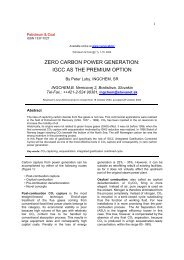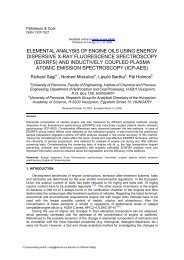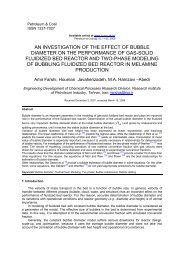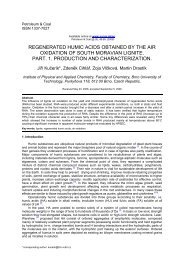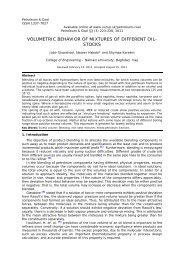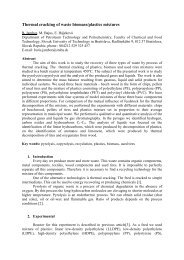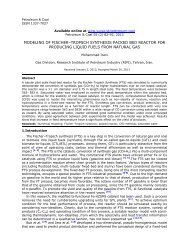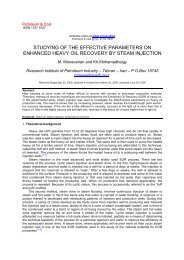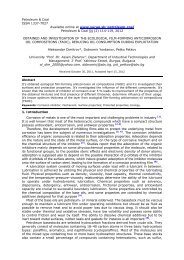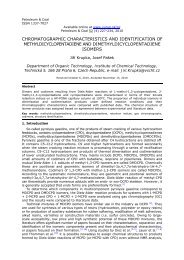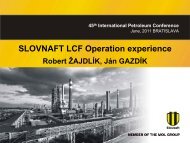syntheses of methylenedianilines over the zeolite catalysts
syntheses of methylenedianilines over the zeolite catalysts
syntheses of methylenedianilines over the zeolite catalysts
Create successful ePaper yourself
Turn your PDF publications into a flip-book with our unique Google optimized e-Paper software.
Petroleum & CoalISSN 1337-7027Available online at www.vurup.sk/pcPetroleum & Coal 52 (4) 273-279, 2010SYNTHESES OF METHYLENEDIANILINES OVER THE ZEOLITECATALYSTSJiří TrejbalInstitute <strong>of</strong> Chemical Technology, Prague, Department <strong>of</strong> Organic Technology,Technická 5, 166 28 Prague 6 - Dejvice, Czech Republic, e-mail: jiri.trejbal@vscht.czReceived November 24, 2010, Accepted December 6, 2010AbstractSyn<strong>the</strong>ses <strong>of</strong> <strong>methylenedianilines</strong> <strong>over</strong> <strong>zeolite</strong>s with various structures were studied. It was foundout that <strong>the</strong> most selective catalyst for <strong>the</strong> syn<strong>the</strong>sis <strong>of</strong> 4,4´-methylenedianiline isomer was <strong>zeolite</strong>Y. Fur<strong>the</strong>r, <strong>the</strong> kinetic data showed that initial N,N´-diphenylmethylenediamine reacted <strong>over</strong> <strong>zeolite</strong><strong>catalysts</strong> by even one order <strong>of</strong> magnitude faster that <strong>the</strong> intermediate product 4-amino-N-benzylaniline.The most suitable temperature range for <strong>the</strong> syn<strong>the</strong>sis <strong>of</strong> 4,4´-methylenedianiline isomer was fur<strong>the</strong>ridentified as a range <strong>of</strong> 100 to 120°C.Keywords: <strong>zeolite</strong>; methylenedianiline; kinetic; aniline; formaldehyde.1. IntroductionMethylenedianilines (MDA) is formed by aniline condensation in <strong>the</strong> presence <strong>of</strong> an acidcatalyst [1] . During <strong>the</strong> syn<strong>the</strong>sis, isomers 2,2´-MDA (0,3 %) and 2,4´-MDA (4 %) als<strong>of</strong>orm apart from <strong>the</strong> required 4,4´-MDA isomer. Trimers and o<strong>the</strong>r heavier polymers <strong>of</strong>aniline and formaldehyde are formed during <strong>the</strong> syn<strong>the</strong>sis apart from dimers (70 %) in<strong>the</strong> reaction mixture. MDA production belongs to high-capacity processes, and it constitutes apreliminary step for production <strong>of</strong> diisocyanate MDI, which is a basic component for production<strong>of</strong> polyurethane materials. This use comprises <strong>of</strong> <strong>over</strong> 90 % <strong>of</strong> MDA consumption. Therest, less than 10 %, is used for production <strong>of</strong> epoxy resins, anti-corrosion materials, dyesand o<strong>the</strong>r special products [2] .The oldest but still nowadays <strong>the</strong> most used catalyst for MDA syn<strong>the</strong>sis is hydrochloricacid. The amount <strong>of</strong> <strong>the</strong> acid used for <strong>the</strong> syn<strong>the</strong>sis is in effect stoichiometric with respectto aniline, which is used in excess with respect to formaldehyde, when <strong>the</strong> formaldehydeconversion is total. The reaction mixture is neutralized by a base, mostly NaOH (Scheme1). A great advantage <strong>of</strong> <strong>the</strong> given procedure is that hydrochloric acid is a relatively cheapchemical substance, and a total conversion and a high yield <strong>of</strong> 4,4´-MDA isomer is reached.On <strong>the</strong> o<strong>the</strong>r hand, hydrochloric acid causes corrosion <strong>of</strong> <strong>the</strong> equipment and neutralization<strong>of</strong> waste salts.2NH 2+2 HCl 2NH 3+ClH2COCl+H 3NCH 2NH 3+Cl2 NaOHN H 2N H 2+ + +CH H CC22NH 2NNHH 2H2 2NH 22NaCl2,2´-MDA 2,4´-MDA 4,4´-MDAScheme 1. The traditional procedure <strong>of</strong> MDA production with <strong>the</strong> use <strong>of</strong> HCl as an acidcatalyst
An alternative procedure <strong>of</strong> 4,4´-MDA production is catalysis by an acidheterogeneous catalyst. Over <strong>the</strong> years, a wide range <strong>of</strong> various catalyst was studied,such as various types <strong>of</strong> diatomaceous earth [3,4] , amorphous aluminosilicates [5] , bariumnitrides [6] , hydroxy ethane sulfonic acid [7] and silver tungstate [8] .Zeolites appear to be <strong>the</strong> most suitable for MDA <strong>syn<strong>the</strong>ses</strong> in recent years. Zeolitesare crystalline aluminosilicates with an exactly defined structure. An advantage <strong>of</strong> <strong>the</strong>sematerials is <strong>the</strong>ir high <strong>the</strong>rmal stability, and also high activity due to <strong>the</strong> crystallinestructure. A negative charge <strong>of</strong> aluminium in <strong>the</strong> <strong>zeolite</strong> structure is compensated bycations, which is H + cation in case <strong>of</strong> an acid catalysis.Clerici et al. [9] indicated <strong>the</strong> use <strong>of</strong> ZSM-5 and Y <strong>zeolite</strong>s, whereas <strong>the</strong> <strong>zeolite</strong>structure could contain boron and titanium. Low aniline conversions up to 30 % andselectivity to 4,4-MDA to 70 % were reached. Kiso et al. [10] gave <strong>zeolite</strong> Y as a suitablecatalyst. Selectivity to 4,4-MDA <strong>of</strong> 82 % was reached on an untreated catalyst, if <strong>the</strong>catalyst was modified by fluorine or ion exchange by various metals, selectivity <strong>of</strong> even92 % could be reached. Perego et al. [11] proposed <strong>the</strong> use <strong>of</strong> <strong>zeolite</strong> Beta, whereasselectivity to 4,4-MDA <strong>of</strong> 50 to 60 % was reached for <strong>the</strong> total conversion. Similarresults were reached in a batch arrangement even in a trickle bed reactor. The sameteam <strong>of</strong> authors in ano<strong>the</strong>r paper [12] recommended modification <strong>of</strong> <strong>zeolite</strong> Beta byphosphorus or boron for increasing <strong>the</strong> selectivity to 4,4-MDA isomer. Corma et al. [13]recommended <strong>the</strong> use <strong>of</strong> <strong>zeolite</strong>s like ITQ-2, ITQ-6 and ITQ-18. The authors presentedthat <strong>the</strong>se <strong>zeolite</strong>s had lower formation <strong>of</strong> side substances like quinazolines, and <strong>the</strong>se<strong>zeolite</strong>s were also more resistant to deactivation. Kugita et al. [14] found out, that <strong>the</strong>activity <strong>of</strong> <strong>zeolite</strong>s to reaction <strong>of</strong> aniline with formaldehyde decreased in a succession <strong>of</strong>Beta > Y > ZSM-5, whereas <strong>the</strong> highest yield <strong>of</strong> 4,4-MDA was reached <strong>over</strong> <strong>zeolite</strong> Y.The objective <strong>of</strong> this work was to test <strong>zeolite</strong> <strong>catalysts</strong> <strong>of</strong> various structures for MDAsyn<strong>the</strong>sis. N,N´-diphenylmethylenediamine aminal (AM, <strong>the</strong> product <strong>of</strong> condensation <strong>of</strong>two molecules <strong>of</strong> aniline and one molecule <strong>of</strong> formaldehyde) was used as <strong>the</strong> startingsubstance, and secondary amine 4-amino-N-benzylaniline (4-SA) was also used. Theformation <strong>of</strong> 4-SA amine is a necessary intermediate step during syn<strong>the</strong>sis <strong>of</strong> 4,4-MDAisomer from <strong>the</strong> aminal. This way, it was possible to differentiate between <strong>the</strong> effect <strong>of</strong><strong>catalysts</strong> on <strong>the</strong> initial aminal and 4-SA intermediate product, which has not beendescribed in literature yet. The pure compounds were used to avoid effect <strong>of</strong> water andformaldehyde polymers which are present if <strong>the</strong> water solution <strong>of</strong> formaldehyde andaniline are used as a starting material.2. Experimental2.1 ChemicalsJiří Trejbal/Petroleum & Coal 52 (4) 273-279, 2010 274Catalysts by Zeolyst company supplied in H form were used for <strong>the</strong> experiments.Aniline (Aldrich 99 %) was distilled in an efficient column with 80 TP. Formaldehyde(operational sample BC-MCHZ) 37 % with a content <strong>of</strong> 11 % methanol was used withoutany modification.Aminal was prepared by mixing formaldehyde and aniline in a molar ratio 1:2, <strong>the</strong> productshould be extracted to e<strong>the</strong>r and several times recrystallized. 4-amino-N-benzylanilinewas prepared by hydrogenation <strong>of</strong> 4-nitro-benzylidenaniline <strong>over</strong> a cobalt catalyst (Grace) ata temperature <strong>of</strong> 70 °C and a hydrogen pressure <strong>of</strong> 5 MPa. 4-nitro-benzylidenaniline wasprepared by condensation <strong>of</strong> 4-nitrobenzaldehyde (Aldrich 99 %) with aniline in methanolenvironment, whereas <strong>the</strong> product was obtained as a yellow crystalline substance (Scheme 2).NH 22 H 2CO+NH C N HH 2 H+ 2OAMNH 2 NO 2+ N C NOOH 2 + H 2OH 2N C NO N CH2NH H 2Ry-CoH24-SAScheme 2. Syn<strong>the</strong>sis <strong>of</strong> initial substances, aminal and 4-amino-N-benzylaniline+H 2O
2.2 Analytical methodsQuantitative analysis <strong>of</strong> reaction mixtures was carried out by means <strong>of</strong> SHIMADZU-GC9gas chromatograph with a Flame Ionization Detector (FID). HP-PONA capillary column(50 m x 0.2 mm, film 1 μm) was used. Helium was <strong>the</strong> carrier gas. Qualitative analysis <strong>of</strong><strong>the</strong> reaction mixtures was carried out by means <strong>of</strong> GC MS-QP 2010 SHIMADZU gaschromatograph equipped with a Mass Spectroscopy (MS) detector. DB-5 capillary column(60 m x 0.32 mm, film 1 μm) and helium as <strong>the</strong> carrier gas were employed. The sampleswere homogenized by methanol and <strong>the</strong>y were analyzed using a method <strong>of</strong> an internalstandard. The correction factors were determined using pure substances as standards.Catalysts were characterized by means <strong>of</strong> temperature programmed desorption (TPD)with <strong>the</strong> use <strong>of</strong> pyridine. From <strong>the</strong> known unit cell size (CBV600 24.33 A, CBV780 24.25A) and with using Fichtner-Schmittler equation [15] <strong>the</strong> content <strong>of</strong> extraframework Al for<strong>the</strong> Y <strong>zeolite</strong>s was calculated. Used <strong>catalysts</strong> are summarized in Table 1.Table 1. Overview <strong>of</strong> used <strong>catalysts</strong> and <strong>the</strong>ir properties (pulse saturation with pyridine ata temperature <strong>of</strong> 200 °C, <strong>the</strong> increase <strong>of</strong> temperature during <strong>the</strong> desorption 10 °C/min to850 °C)Zeolite Si/Al TPD Pyridine(μmol/g cat )Al(μmol/g cat )Ss(m 2 /g cat )Al ext (%)Y (CBV600) 2.6 280 4330 660 77.6Y (CBV780) 40 137 407 720 50ZSM-5 (CBV8014) 40 370 407 425 -Beta (CP811E-75) 37.5 277 434 450 -Mordenite (CBV90A) 45 257 363 500 -2.3 Catalytic testA molar ratio <strong>of</strong> aniline:aminal or aniline:4-SA = 20:1 was in <strong>the</strong> reaction mixture at<strong>the</strong> beginning. The total amount <strong>of</strong> <strong>the</strong> reaction mixture was about 50 g. This mixturewas heated to <strong>the</strong> required temperature in an oil bath, and <strong>the</strong>n a catalyst freshly calcinatedto 550 °C was added. The <strong>zeolite</strong> was in a form <strong>of</strong> powder in all cases. The reaction wascarried out with stirring at atmospheric pressure, and samples were taken out continuously.3. DiscussionJiří Trejbal/Petroleum & Coal 52 (4) 273-279, 2010 275If aminal and aniline were <strong>the</strong> starting substances and <strong>zeolite</strong> was <strong>the</strong> catalyst, at firstsecondary amines would form in <strong>the</strong> first step (Scheme 3). It is fur<strong>the</strong>r obvious from <strong>the</strong>chemism that secondary amines did not form by an intramolecular rearrangement <strong>of</strong> aminal,but by a gradual substitution reaction, where <strong>the</strong> presence <strong>of</strong> <strong>the</strong> amine was necessary.Generally, substitution to 2, 3 and 4 positions was possible, whereas 2 and 4 positionswere preferred with respect to <strong>the</strong> character <strong>of</strong> <strong>the</strong> reaction (electrophilic substitution,NH- group is a substituent <strong>of</strong> <strong>the</strong> first group). 2-SA and 4-SA isomers were found andobserved <strong>over</strong> all <strong>zeolite</strong>s, 3-SA isomer was not detected at all.NH 2NH C NH 2 H+AMZeoliteH 2NNH 2NH 2NNHH C 2 + N C N CH 2 H+H2 H+H24-SA 2-SA 3-SAdHr = -43.5 kJ/molScheme 3. Syn<strong>the</strong>sis <strong>of</strong> secondary amines from aminalThe secondary amines reacted in <strong>the</strong> second step to final MDA isomers. Scheme 4shows an example for 4-SA isomer. Substitution to 2, 3 and 4 positions was possibleagain, and <strong>the</strong> presence <strong>of</strong> aniline was also necessary.
Jiří Trejbal/Petroleum & Coal 52 (4) 273-279, 2010 276N H 2N H 2CH 2H 2NC NHH 22NH 2NH 2NH C H 2NH 2+4-SAZeolitedHr = -21.7 kJ/mol++ H 2N+NH 2CH22,4´-MDA 4,4´-MDA 3,4´-MDAScheme 4. Syn<strong>the</strong>sis <strong>of</strong> MDA isomers from 4-amino-N-benzylanilineWhen 4-SA isomer was used as <strong>the</strong> starting substance, even substitution to 3 positionwas observed, though 3,4´-MDA isomer formed only in a small quantity (Figure 1). Formation<strong>of</strong> this isomer can be explained by <strong>the</strong> ability <strong>of</strong> <strong>the</strong> catalyst to protonate NH 2 group (NH 3 + groupis a substituent <strong>of</strong> <strong>the</strong> second group) possibly by steric selectivity <strong>of</strong> <strong>the</strong> catalyst. 3,4´-MDA isomer formed most <strong>over</strong> <strong>zeolite</strong> Beta (3.2 % <strong>of</strong> <strong>the</strong> total MDA isomers at <strong>the</strong> totalconversion <strong>of</strong> 4-SA) <strong>the</strong> least <strong>the</strong>n <strong>over</strong> <strong>zeolite</strong> Y with a low ratio <strong>of</strong> Si/Al (0.4 % <strong>of</strong> <strong>the</strong>total MDA isomers at <strong>the</strong> total conversion <strong>of</strong> 4-SA).Fig. 1. Formation <strong>of</strong> 3,4´-MDA isomer from 4-amino-N-benzylaniline <strong>over</strong> <strong>zeolite</strong> <strong>catalysts</strong> (150°C, 50 gmixture with <strong>the</strong> molar ratio aniline/4-SA = 21.5,0.3 g <strong>zeolite</strong>)Fig. 2. Aminal conversion versus time relative toone gram <strong>of</strong> <strong>the</strong> catalyst (150°C, 50 g mixturewith <strong>the</strong> molar ratio aniline/aminal = 21.5)It was found out that <strong>zeolite</strong>s <strong>of</strong> <strong>the</strong> structure Y and Beta were <strong>the</strong> most active <strong>catalysts</strong> for<strong>the</strong> aminal reaction. On <strong>the</strong> contrary, Mordenite and ZSM-5 showed very low activity(Figure 2). In each experiment <strong>the</strong> same amount <strong>of</strong> <strong>the</strong> reaction mixture was used butdifferent amount <strong>of</strong> catalyst. Thus for <strong>the</strong> correct comparison <strong>of</strong> <strong>the</strong> <strong>catalysts</strong> activityreduced time was used (time which corresponds to using 1 g <strong>of</strong> catalyst). This was probablydue to <strong>the</strong> crystalline structure <strong>of</strong> <strong>the</strong> <strong>zeolite</strong>s, when <strong>zeolite</strong> Y had great inner cavities for<strong>the</strong> reaction, and <strong>zeolite</strong> Beta had relatively great channels. On <strong>the</strong> contrary, <strong>zeolite</strong> ZSM-5and Mordenite had lower inner dimensions <strong>of</strong> <strong>the</strong> channels. When two <strong>zeolite</strong>s <strong>of</strong> Y structurewith different Si/Al ratios were compared, <strong>the</strong>n it is obvious that <strong>the</strong> <strong>zeolite</strong> with Si/Alratio = 2.6 was about twice active than <strong>the</strong> <strong>zeolite</strong> Y with Si/Al ratio = 40. This is in accordwith a performed characterization by means <strong>of</strong> TPD technique, when about twice <strong>the</strong> amount<strong>of</strong> active centers able to adsorb pyridine was found for <strong>the</strong> <strong>zeolite</strong> Y with Si/Al = 2.6 (Table 1).Theoretically, each Al atom in <strong>the</strong> <strong>zeolite</strong> structure should represent one active center,though, as <strong>the</strong> characterization showed, not all <strong>the</strong> centers were available to molecules,which were more volume demanding, like pyridine. And <strong>the</strong>se considerations also applyfor sterically demanding molecule <strong>of</strong> aminal and its products. Also some affect <strong>of</strong> extraframeworkAl (77.6 % against to 50 %) may be responsible to higher activity <strong>of</strong> <strong>zeolite</strong> Y with Si/Al = 2.6.Zeolites Y and Beta again suited <strong>the</strong> most with respect to <strong>the</strong> selectivity to <strong>the</strong> requiredproduct, 4-SA (Figure 3). Zeolites ZSM-5 and Mordenite showed a low yield <strong>of</strong> 4-SA isomer whichcould be related to <strong>the</strong>ir relatively lower channel structure in comparison with <strong>zeolite</strong>s Y and Beta.If 4-SA secondary amine syn<strong>the</strong>tically prepared was used as <strong>the</strong> starting substance, itwas observed that <strong>zeolite</strong>s Y and Beta were again <strong>the</strong> most active (Figure 4) and <strong>zeolite</strong>Y was <strong>the</strong> most selective to <strong>the</strong> required isomer, 4,4´-MDA (Figure 5). The results indicatethat <strong>the</strong> most suitable catalyst for selective preparation <strong>of</strong> 4,4´-MDA isomer from aminalwas <strong>zeolite</strong> Y. On <strong>the</strong> contrary, if it was required to prepare a mixture <strong>of</strong> isomers with a
Jiří Trejbal/Petroleum & Coal 52 (4) 273-279, 2010 277high content <strong>of</strong> 2,4´-MDA isomer, <strong>the</strong>n <strong>zeolite</strong> Mordenite was <strong>the</strong> most suitable. Theresults are in agreement with literature data [9-14] from <strong>the</strong> point <strong>of</strong> view <strong>the</strong> <strong>catalysts</strong>activity. It was found <strong>the</strong> second step (conversion <strong>of</strong> 4-SA) has affect on <strong>the</strong> <strong>over</strong>all lowselectivity <strong>of</strong> formation 4,4-MDA <strong>over</strong> Beta <strong>zeolite</strong> as reported Perego et al. [11]Fig.3. 4-SA isomer content versus aminal conversion(150°C, 50 g mixture with <strong>the</strong> molar ratioaniline/aminal = 21.5Fig.4. 4-SA conversion versus time related to onegram <strong>of</strong> <strong>the</strong> <strong>catalysts</strong> (150°C, 50 g mixture with<strong>the</strong> molar ratio aniline/4-SA = 21.5)Fig. 5. 4,4´-MDA isomer content versus 4-SAconversion (150°C, 50 g mixture with <strong>the</strong> molarratio aniline/4-SA = 21.5Fig. 6. 4-SA conversion on time related to onegram <strong>of</strong> <strong>the</strong> catalyst (150°C, 50 g mixture with<strong>the</strong> molar ratio aniline/4-SA = 21.5)No catalyst deactivation was observed for <strong>the</strong> experiments with 4-SA. On <strong>the</strong> contrary,<strong>the</strong> deactivation was observed for <strong>the</strong> experiments with aminal, when after a fast reaction <strong>of</strong>aminal <strong>the</strong> conversion <strong>of</strong> secondary amines proceeded very slowly by one order <strong>of</strong> magnitudeslower than for experiments with pure 4-SA isomer, and conversion <strong>of</strong> secondary aminesdid not occur at all (Figure 6). It can be deduced from <strong>the</strong>se findings that <strong>the</strong> substance,which had an effect on catalyst deactivation was formaldehyde, which could be formedfrom aminal (decomposition to formaldehyde and aniline is <strong>the</strong> reverse reaction to aminalformation, and traces <strong>of</strong> water could be present in aniline or as humidity in <strong>the</strong> catalyst),and it could form carbon deposits in <strong>the</strong> catalyst. In terms <strong>of</strong> industrial implementation, itis necessary that water is completely removed from <strong>the</strong> starting mixture.It is obvious from a comparison <strong>of</strong> <strong>the</strong> rates <strong>of</strong> both reaction steps that <strong>the</strong> same <strong>catalysts</strong>were by about one order <strong>of</strong> magnitude more active for aminal conversion than for 4-SAisomer conversion at all cases. This can be explained by an effect <strong>of</strong> <strong>the</strong>rmodynamics,when aminal had energetically demanding arrangement (C-N-C-N-C bond), meanwhile 4-SA isomer was secondary amine (C-N-C-C bond), and thus it represented an arrangementless energetically demanding. Even <strong>the</strong> reaction enthalpies corresponded to this explanation [16] ,which was -43.5 kJ/mol for <strong>the</strong> aminal conversion to secondary amine, and it was only -21.7 kJ/mol for secondary amine conversion to MDA. Ano<strong>the</strong>r possible explanation is thatC-N-C-N-C arrangement in aminal was less hindered by aromatic rings, and thus it wasbetter accessible for substitution on aniline.With respect to <strong>the</strong> fact that <strong>zeolite</strong> Y with Si/Al ratio = 2.6 appeared to be <strong>the</strong> mostselective to <strong>the</strong> formation <strong>of</strong> 4,4´-MDA isomer, it was fur<strong>the</strong>r tested in detail. Kinetics <strong>of</strong>aminal conversion to secondary amines was measured, and <strong>the</strong>n kinetics <strong>of</strong> 4-SA isomerto MDA isomers was measured separately. Following equations were proposed to describe <strong>the</strong>kinetics:
= k.mr12= k.mcatcat. C. CAminal4−SA. C. CAnilinAnilinJiří Trejbal/Petroleum & Coal 52 (4) 273-279, 2010 278Only substitution to 4 and 2 positions was considered in <strong>the</strong> model. Experimental datawere processed by means <strong>of</strong> ERA s<strong>of</strong>tware [17] . The results <strong>of</strong> <strong>the</strong> kinetic measurementsare summarized in Table 2., and Figure 7 and Figure 8 presents <strong>the</strong> agreement <strong>of</strong> <strong>the</strong>kinetics models with <strong>the</strong> experimental data.Table 2. Rate constants and activation energies for reaction <strong>of</strong> aminal and 4-SA conversionReactionAniline/reactant(mol ratio)Rate constant at 120 °C(L.g -1 cat .mol -1 .h -1 )Activation energy(kJ/mol)AM >> 4-SA 13.5 0.198 ± 0.009 81.0 ± 2.5AM >> 2-SA 13.5 0.0229 ± 0.0016 103.2 ± 2.0AM >> 4-SA 21.5 0.185 ± 0,011 78.9 ± 2.3AM >> 2-SA 21.5 0.0205 ± 0.0016 110.8 ± 1.64-SA >> 4,4´-MDA 21.5 0.0192 ± 0.0013 106.4 ± 2.14-SA>> 2,4´-MDA 21.5 0.00112 ± 0.000089 123.0 ± 2.1Several conclusions can be drawn from <strong>the</strong> results. Aminal reacted at 120°C by oneorder <strong>of</strong> magnitude faster than 4-SA, and also substitution to position 2 was in case <strong>of</strong>aminal by one order <strong>of</strong> magnitude slower. Substitution to 2 position had greater activationenergy (103.2 kJ/mol compared to 80 kJ/mol), and it proceeded faster at higher temperatures.Starting molar ratio did not have a great effect on <strong>the</strong> kinetics.Fig. 7. Comparison <strong>of</strong> <strong>the</strong> kinetic model <strong>of</strong>aminal conversion with <strong>the</strong> experimental data(50 g mixture with <strong>the</strong> molar ratio aniline/aminal=21.5, 0.1 g <strong>zeolite</strong> Y, Si/Al = 2.6)Fig. 8. Comparison <strong>of</strong> <strong>the</strong> kinetic model <strong>of</strong> 4-SAconversion with <strong>the</strong> experimental data (50 gmixture with <strong>the</strong> molar ratio aniline/4-SA= 21.5,0.3 g <strong>zeolite</strong> Y, Si/Al = 2.6)If 4-SA was <strong>the</strong> starting compound, substitution to position 4 was 17 times faster thansubstitution to 2 position at a temperature <strong>of</strong> 120°C. Substitution to 2 position had againhigher activation energy (123 kJ/mol compared to 106.4 kJ/mol), and it proceeded fasterat higher temperatures.With respect to obtaining as high yield <strong>of</strong> 4,4´-MDA isomer from aminal as possible, itis purposeful to run <strong>the</strong> process at lower temperatures. However, this is limited by <strong>the</strong>presence <strong>of</strong> amines, which occupy all <strong>the</strong> active acid center irreversibly due to <strong>the</strong>ir basicityeven at temperatures below 100°C, and <strong>the</strong> catalyst is not active for <strong>the</strong> conversion <strong>of</strong>aminal and secondary amines. From <strong>the</strong> process perspective also, primarily with <strong>the</strong> respectto <strong>the</strong> reaction rate and thus to <strong>the</strong> size <strong>of</strong> <strong>the</strong> reactor, it is suitable to carry out <strong>the</strong>reactions at temperatures 100 to 120°C.4. ConclusionsZeolite Y especially with low Si/Al ratio appeared to be <strong>the</strong> most selective catalyst forsyn<strong>the</strong>sis <strong>of</strong> 4,4´-MDA isomer among a large number <strong>of</strong> tested <strong>catalysts</strong>. The extent <strong>of</strong>substitutions to position 2 was low and also <strong>the</strong> substitution to position 3 was very limited forthis <strong>zeolite</strong> at temperatures up to 120°C. The conversion <strong>of</strong> aminal <strong>over</strong> <strong>zeolite</strong> <strong>catalysts</strong>was by one order <strong>of</strong> magnitude faster that <strong>the</strong> conversion <strong>of</strong> secondary amines that areintermediate products for MDA isomer syn<strong>the</strong>sis.
Jiří Trejbal/Petroleum & Coal 52 (4) 273-279, 2010 279AcknowledgmentThe project was carried out with a support <strong>of</strong> grant No. 104/08/P496, Czech Science Foundation.Symbols usedMDAAM4-SA3-SA2-SA4,4´-MDA3,4´-MDA2,4´-MDATPDSsReferencesMethylenedianilinesN,N´-diphenylmethylenediamine4-amino-N-benzylaniline3-amino-N-benzylaniline2-amino-N-benzylaniline4,4´-Methylenedianiline3,4´-Methylenedianiline2,4´-MethylenedianilineTemperature Programmed DesorptionSpecific surface[1] Sprung, M. A.:Chem. Rev., 1940, 26, 297-338.[2] Twitchett, H. J.:Chem. Soc. Rev. 1974, 3, 209-230.[3] Sayigh, A. , Sun, K. K. , Ulrich, H.: US Patent 4 008 275, 1977.[4] Frulla, F.F., Sayigh, A., Ulrich, H., Withman, P. J.: US Patent 4 039 581, 1977.[5] Marquis, E. T., Watts, J., Lewis, W.:US Patent 4 052 456, 1977.[6] Marquis, E. T., Watts, J., Lewis, W.: US Patent 4 053 513, 1977.[7] Marquis, E. T., Brader, J., Walter, H.: US Patent 4 212 821, 1979.[8] Marquis, E. T., Watts, J., Lewis, W.: US Patent 4 286 107, 1980.[9] M. Clerici, G. Bellussi, U. Romano, Euro Patent 0 264 744, 1987.[10] Kiso, Y., Takai, T., Hayashi, T.: Euro Patent 0 329 367, 1989.[11] Perego, C., de Angelis, A., Farias, O., Bosetti, A.: US Patent 6 380 433, 2000.[12] de Angelis, A. , Perego, C., Farias, O., Bosetti, A.: World Patent 2 088 067, 2001.[13] Corma, A., Botella, P., Mitchell, C.: Chem. Commun. 2004, 2008-2010.[14] Kugita, T., Hirose, S., Namba, S.: Catal. Today 2006, 111, 275-279.[15] Fichtner-Schmittler, H., Lohse, U., Engelhardt, G., Patzelova, V.: Cryst. Res.Technol. 1984, 19, K1-K3.[16] Kishore, K., Santhanalakshmi, K. N. : Therm. Acta 1983, 68, 59-74.[17] Zámostný, P., Bělohlav, Z.: Comput. Chem. 1999, 23, 479-485.



